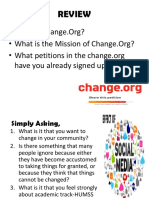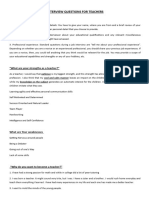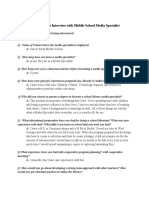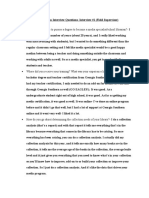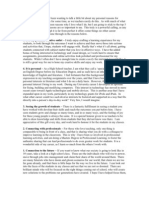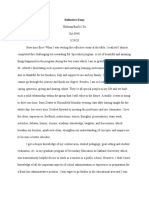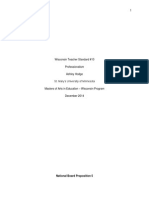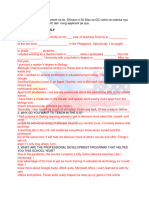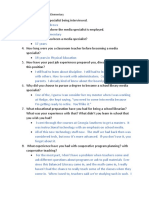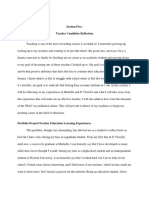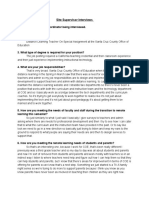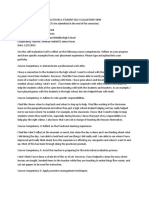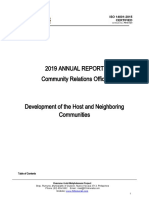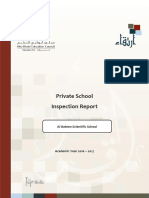Professional Documents
Culture Documents
Jim Harmon Interview 6-7-12 W Notes
Uploaded by
Terry S. AtkinsonOriginal Description:
Original Title
Copyright
Available Formats
Share this document
Did you find this document useful?
Is this content inappropriate?
Report this DocumentCopyright:
Available Formats
Jim Harmon Interview 6-7-12 W Notes
Uploaded by
Terry S. AtkinsonCopyright:
Available Formats
SKYPE Interview with Jim Harmon 10th Grade English Language Arts teacher Euclid High School Euclid,
Ohio June 7, 2012 T: At last years ISTE conference, I heard Lynne Schrum talk about the study she and Barb Levin did profiling eight visionary schools that are high achievers in how they approach technology. Two ECU colleagues and I are interested in teachers who are not in these visionary environments, but innovate and charge ahead with tech integration on their own. Particularly, we are interested in those teachers who are self-motivated and willing to take the risk to learn with and alongside their students by PUTTING TECHNOLOGY INTO STUDENTS HANDS. After reading your Learning and Leading article, I believe that you are indeed one of these teachers. Would you agree? J: I would say I am more of a creative teacher because I am always trying new things to get my students attention. In a way, this is about technology innovation. But things come to me in the middle of the night and I think, Ive got to try something like that. This may seem crazy or totally different from what I have done before, but its just so crazy that it might actually work for students. T: What has been your motivation for using technology as a part of your creative teaching? J: Seeing kids grasp the content that I am responsible for teaching. Content is king and my job is to teach kids not just the nuts and bolts of literacy, but my goal, personally, is to teach them to love reading
and writingto see it as a viable, essential tool for their lives. Thats really a life ticket, if you will, because without that skill, they will not go as far as they could. Basic literacy and even advanced literacy can really make a difference in their lives, both personally and professionally. T: You mentioned that many of your students are at-risk. Tell me a bit about your student population. J: Euclid is a strange environment. The city is about 50/50 African American and Caucasian. It is a community in transition as there has been a large influx of African-Americans moving into Euclid. Its an inner-ring suburb of Cleveland. We have families who have left the Cleveland schools and are moving to Euclid because they have been unsatisfied with the education where they were. Weve experienced white flight because of that. The school itself is about 90% AfricanAmerican. It is not representative demographically of the community at large. A lot of the white families have taken their kids out and put them either into charter or parochial schools. So we are at 75-85% free and reduced lunch and have significant poverty in our district. Many families have been disenfranchised from education, even though they moved to Euclid to get a better education for their kids. They dont necessarily get the importance of education, in terms of the big picture. I think they realize the importance of education but they dont understand the familial commitment it takes. T: So are parents present in the school? J: I would say moderately. I also taught in Cleveland and was laid off in 2004, so I can use that as a comparison. On parent-teacher conference nights in Cleveland, I might see 5% of parents. Whereas in Euclid, I would say probably 30-40%. Thats a significant difference. Not enough, but still significant.
T: You mentioned in your Learning and Leading article that the districts director of instructional technology gave you an iPad to experiment with and consider how the school might integrate it into the English curriculum at Euclid High School. Could you tell me more about this? J: Sure, Im a huge geek. I love new gadgets, toys, and I am always thinking about how they might fit into my teaching. As an Apple Distinguished Educator, I was getting ready to attend one of our Summer Institutes. I knew that the iPad was the hot thing, so having it in my hand was important so I could see the apps in use. But even before that, when I got it about a month before the year ended, I put it on my desk one day and the kids gravitated to it. It was like Pandoras box, in a good way but it almost felt disruptive. I thought, Weve got to put this thing away and focus on my teaching. I was amazed by how the kids were drawn to it. The operating system was essentially an iPhone or and iPod and they are familiar with these so I didnt have to teach them how to use it. Then it kind of snowballed. Once I saw their reaction, I started learning more about it from other teachers around the country in the Apple network. Honestly, I dont think I realized how significant it was until I did the study. Most teachers who are innovators probably have a pretty significant idea about something they want to try and about its relative success. T: So do you conduct action research routinely in your class? J: Yes, I think it is an important part of being a good teacher. Aside from being an effective teacher, I want to know what students think. I want to know their perception. Twice a year I have students evaluate me using a Google Form. I promise that I will not track them, but I am just genuinely interested in if my teaching is serving them, reaching them in a way that is best for them. So that is a simple form of action research. I am also involved with the MUST program, an urban teacher prep program at Cleveland State University. So most every year, I have an intern in a yearlong experience who is making a commitment to learning about how to teach in an urban environment. It gets them
really ready for the classroom. One of the things they have to do is an action research project. This is one of the reasons I love this program because I believe in this and see great value in this research and the program. When they come in, we frequently talk about technology. This is partly because I am a big geek and also because it is fun. I am always worrying about what I call the PowerPoint effect. Everybody uses PowerPoint as presentation software. The first time I taught with a PowerPoint, the kids were riveted. Now, you pull out a PowerPoint and their eyes glaze over. I worry about things getting so routine that kids are going to get turned off and feel like it is a repetition of the same act over and over again. Thats always a challenge as a teacher because you do want repeated performance over time to show learning and mastery, but at the same time you can get into a rut. T: It seems to me, based on what you are saying, that you take pride in your exceptionalism. Do you enjoy being out there on the edge? Have you thought about yourself in this way? J: No, not really. I like to share. If I find something that works, it can have the same effect on other teachers. Now Im not saying that the iPad is a magic bullet. Its impact depends on how I use the device and what I do as a teacher. If I can share that this is more than just using technology, here is some theory, some strategies that go along with it, then it can have value. Just this week, I was doing some professional development and when I am sharing like that, I realize that what I am doing is pretty amazing. The teachers I was sharing with said that this was the best professional development that they had had all year. So that makes me feel good, makes me feel OK, that even though this feels routine to me, I am not only making an impact on students, but on other teachers as well. T: Were these teachers in your own system? J: They are from the Cleveland Schools, actually.
T: So how did they know about Jim Harmon? J: Thats a good question. As an innovator one of the things I am asked to do is to provide professional development through our local PBS affiliate. The PBS affiliate has workshops where teachers get an iPad and a 3-hour session teaching them what to do with it. One of the principals in the school where I was laid off in 2004 was at one of the inservices that I taught and he said, Wow, weve got to get you in our school because we are getting iPads in our school next year with our Race To The Top money. We really need some direction. T: Quite a compliment. J: Yes, it was. T: The PBS workshopsis this an opportunity that you sought out? J: No, I found out about them through Apple as an Apple Distinguished Educator. I continue to be humbled by that experience. It has opened a whole lot of doors for me. Even getting the article published in Learning and Leading. I dont know if it would have been published if I hadnt been an Apple Distinguished Educator. T: So the opportunity to become an Apple Distinguished Educator, was that achieved through your own initiative? J: It was through my own initiative, but my district supported me and thats important to note. You can be an innovative teacher and have your district get in the way. I feel so fortunate to have a district that supports me. My peers, my principals, the superintendent, and the director of instructional technology support know what I do and I know I wouldnt have accomplished all that I have without having them on the same playing field.
T: Two colleagues and I have been observing teachers in local schools and we are finding that about 2/3 of them use tech primarily as a presentation or instructional delivery toolrarely is use of technology put into student hands. How have you moved beyond this presentation/delivery approach? Why was that important to you? J: I remember the day that I realized it was important. It was a day that I came to school about 12 years ago not feeling well. I was a computer teacher at that time and I wanted to provide the best support for students, so I told the kids that we were going to take a break that day. They could work on homework or review and practice what we had already learned. They came to me and asked if they could work on their technology projects on their own. I told them to go ahead and all of a sudden all of the students were in their groups working on their projects without me guiding their every move. I wasnt doing action research at the time, but this was an aha moment for me. T: So it was really serendipitous that this happened? J: Yes. T: Do you have ideas about how others can have such an epiphany other than through a serendipitous event like you experienced? How do you move colleagues who are not innovators like you are beyond using tech simply for instructional presentation? J: I wish I had that answer. In fact, I crave that answer. I do think it is a matter of putting teachers in an environment where they are comfortable making mistakes and knowing that they can fail. We are starting to talk about his with our students by telling them that it is OK to make a mistake, to fail. This is the place where you can do this. I joke with my teacher interns and tell them that as long as nobody dies, the risk is worth it. I think there is a fear of technology and thoughts like, Oh my gosh, I might break it, something might go wrong. I am really careful to tell people in professional development that when
they do some of this, things are going to go wrong. Its going to be frustrating. But dont give up on it. The more you use technology, the more you learn from your mistakes, it will get better. Thats really the idea. The students are already there. They are motivated to use the technology. Thats the beautiful thing about putting an iPad in a students hands. Theres one WordFlick app that we used all year long and I never got a complaint from students. Its a good vocabulary builder, much like Scrabble or Words With Friends. These kids eat this game up and it just blows me away to see them pull out their vocabulary packets from past weeks and months and search for words they can spell. As an English teacher, we talk all the time about what we want to see from kidsrepeated exposure to new words! Thats why this action research project spoke to me personally. The potential for tablet computers and the apps to differentiate is phenomenal. T: So its the capability of the apps to differentiate that makes the iPad different? J: Yes, it makes me a better teacher. T: If you had advice for building level administrators (ICs/Principals) for how to encourage "early adopters" such as yourself to innovate and charge ahead with projects, what would it be? J: Let early adopters try the tech themselves. As teachers we want to help kids, but we also want to feel good about what we do. Getting recognition from administrators says, I see you as an intelligent person, I see you as a leader. Having that kind of trust put in you is important. It says something to you and motivates you. T: What about advice for system level administrators (Directors of IT, Superintendents)? J: Trust your teachers. Thats critical. Earlier, I mentioned that my system trusts me to the point that if I need to bring up YouTube or
Facebook in my classroom, I can put in the password and override the firewall. So if its a teachable moment, its a teachable moment and they trust me to recognize that and use that power responsibly. I dont know how to put it any more simply than thatTrust your teachers. You know year after year, no matter what school district I work in, we pay consultants thousands and thousands of dollars to come in and tell us what we already know. I look around me where I teach and I see all of the consultants we need in the room next to me and across the building. We all have the answerswe just have to be trusted and allowed the collaboration time to share. T: In your opinion, how can we foster innovation with technology in teacher prep programs? J: Better partnerships between universities and schoolsstrong mentors need to be identified. I am now the coordinator for Cleveland States MUST program in my school. What we want to see is more coteaching with mentors who are solid in pedagogy, philosophy, content, and technology. They must know the T-PACK model and help preservice teachers know how to put it all together. It has to be more than saying, Oh cool, iPadsput them in the kids hands and lets see what happens. Teachers have to say, Heres what I need to teachwhat tools can I use to do that? Also, not all teachers are great mentors. Thats really important. If you are putting a student intern in the care of an inservice teacher, they must serve the student teacher well. T: Youve talked about your credence as a presenter, a mentor because you are a teacher who actually teaches with technology in your own classroom. J: Yes, I wouldnt have the credibility that I have if I didnt talk about where the rubber meets the road.
T: What do you see as your next step/project in terms of tech integration? What will you need to make it succeed? J: Right now I am going to focus on the iPad. Improving techniques about how to use it. I am also interested in creating my own textbooks using Apples newly released iBook authoring software. This allows anyone to create their own textbooks. Not only am I interested about this with the advent of the Common Core Standardsthats a scary thing for many teachers, including me. We have these textbooks that we use 30 percent of here and there and I know I can do a better job by creating my own textbook. I am also wondering what will happen if I give my students the ability create their own textbooks. This might be my own personal direction, but Ill have a new intern in the fall and well see where that takes us. My district is also considering a 1-1 program. Im really interested in seeing how that goes because Ive seen other districts think that just because they give all the kids a piece of technology and its going to be wonderful. I have yet to see that happen. Yes, there are schools like those utopic environments you mentioned earlier, but I want to see what we can do to figure out how we can make this work as a district for our students. I am voting for iPads for this 1-1its a no-brainer. There are things that it can do with the app capability that laptops simply cannot. Now it will be up to me to try and convince colleagues and administrators that this is the way to go. T: Jim, this has been a pleasure. I really appreciate your time. J: Thank you, Terry. I look forward to reading the column.
You might also like
- Teacher Interview QuetionsDocument16 pagesTeacher Interview QuetionsEdwin TuckerNo ratings yet
- Making Every Lesson Count: Six principles to support great teaching and learning (Making Every Lesson Count series)From EverandMaking Every Lesson Count: Six principles to support great teaching and learning (Making Every Lesson Count series)Rating: 5 out of 5 stars5/5 (1)
- Teaching PlatformDocument10 pagesTeaching Platformapi-337799732No ratings yet
- Participate and Assist: Classroom Environment Before Classroom Environment NowDocument6 pagesParticipate and Assist: Classroom Environment Before Classroom Environment NowMark Warren Atienza Revellame67% (3)
- Take Home Examination: Semester January 2020Document17 pagesTake Home Examination: Semester January 2020Muhammad Fakhrul Najmi Jaafar100% (2)
- B.ed CurriculumDocument29 pagesB.ed CurriculumAkash MukherjeeNo ratings yet
- Concept paper-COTDocument16 pagesConcept paper-COTMyleneNo ratings yet
- Portfolio 5Document9 pagesPortfolio 5Eiram DheeNo ratings yet
- BS Iso Iec 19796-3-2009Document50 pagesBS Iso Iec 19796-3-2009Олег Соловьев100% (1)
- WWW Dayjob Com Content Food Hygiene Quiz 829 HTMDocument12 pagesWWW Dayjob Com Content Food Hygiene Quiz 829 HTMJulay Cassandra DaioNo ratings yet
- Assigment-Teacher Is The Agent of ChangesDocument3 pagesAssigment-Teacher Is The Agent of ChangesZakri Malek Zeq100% (2)
- Teacher InterviewDocument4 pagesTeacher InterviewShahhoossen jamalNo ratings yet
- Reflective Summary ReportDocument7 pagesReflective Summary Reportapi-273344635No ratings yet
- LeadershipplatformDocument5 pagesLeadershipplatformapi-288544875No ratings yet
- Chinese Teacher As Teacher and Learner: MACT Synthesis PaperDocument8 pagesChinese Teacher As Teacher and Learner: MACT Synthesis Paperapi-314843306No ratings yet
- I First Became Aware That There Might Be A Problem A Few Years Ago, When One of My Kids WasDocument5 pagesI First Became Aware That There Might Be A Problem A Few Years Ago, When One of My Kids WasRoscela Mae D. ArizoNo ratings yet
- FS 1 - LEARNING-WPS OfficeDocument4 pagesFS 1 - LEARNING-WPS OfficeRhea Mae PaglinawanNo ratings yet
- Service Learning: Context Statement Type of Article: Journal Entries and Epilogue DateDocument15 pagesService Learning: Context Statement Type of Article: Journal Entries and Epilogue Dateapi-336129230No ratings yet
- Job InterviewDocument2 pagesJob InterviewGianna MichaelsNo ratings yet
- Secondary Site Interview With Middle School Media SpecialistDocument3 pagesSecondary Site Interview With Middle School Media Specialistapi-462816920No ratings yet
- Why Did You Decide To Become A Teacher?: QuestionsDocument13 pagesWhy Did You Decide To Become A Teacher?: QuestionsTan Suk WanNo ratings yet
- School Librarian Interview Questions - 1 Field SupervisorDocument6 pagesSchool Librarian Interview Questions - 1 Field Supervisorapi-465311379No ratings yet
- Section Two: Teacher Candidate Background ExperiencesDocument20 pagesSection Two: Teacher Candidate Background Experiencesapi-418436856No ratings yet
- School Librarian Interview Questions - 1 Field SupervisorDocument8 pagesSchool Librarian Interview Questions - 1 Field Supervisorapi-465311379No ratings yet
- Weebly Section 6Document7 pagesWeebly Section 6api-487421290No ratings yet
- What's WRONG With The Education System in Malaysia? - From A Student's PerspectiveDocument6 pagesWhat's WRONG With The Education System in Malaysia? - From A Student's PerspectivekomNo ratings yet
- It Is My Primary Creative OutletDocument4 pagesIt Is My Primary Creative OutletA'isyah HishamuddinNo ratings yet
- Grimes Synthesis PaperDocument10 pagesGrimes Synthesis Paperapi-231366956No ratings yet
- Introduce Yourself / Tell Something About YourselfDocument21 pagesIntroduce Yourself / Tell Something About YourselfJespher GarciaNo ratings yet
- Xu Reflective EssayDocument4 pagesXu Reflective Essayapi-469710033No ratings yet
- Teaching ResumeDocument2 pagesTeaching Resumeapi-417358995No ratings yet
- Portfolio Section 6Document7 pagesPortfolio Section 6api-360338728No ratings yet
- Pjilos of Edu FinalDocument3 pagesPjilos of Edu Finalapi-220472700No ratings yet
- Middle School Media Specialist InterviewDocument5 pagesMiddle School Media Specialist Interviewapi-462781772No ratings yet
- Section TwoDocument17 pagesSection Twoapi-417799551No ratings yet
- Finalpaperwts 10Document11 pagesFinalpaperwts 10api-271980347No ratings yet
- NADELA Act7Document1 pageNADELA Act7DOROTHY JOY NADELANo ratings yet
- PhilosophyDocument7 pagesPhilosophyapi-297104865No ratings yet
- Teaching Methods - John Fleming - Explicit Instruction Myths and 15 Sept 2015Document3 pagesTeaching Methods - John Fleming - Explicit Instruction Myths and 15 Sept 2015Eric ChanNo ratings yet
- Final Portfolio ActivitiesDocument15 pagesFinal Portfolio ActivitiesSundos MuradNo ratings yet
- Section Two Teacher Candidate Background ExperiencesDocument13 pagesSection Two Teacher Candidate Background Experiencesapi-469430606No ratings yet
- Brendan Murphy - Changing Nature of PDDocument7 pagesBrendan Murphy - Changing Nature of PDClassroom 2.0 BookNo ratings yet
- Graphic OrganizerDocument13 pagesGraphic Organizer慧莉No ratings yet
- Ardf4oim Sassatelli Msed Portfolio Personal StatementDocument11 pagesArdf4oim Sassatelli Msed Portfolio Personal Statementapi-251240984No ratings yet
- Suggestions For Principals Transform Teaching Article 2013Document9 pagesSuggestions For Principals Transform Teaching Article 2013Jk McCreaNo ratings yet
- Teachers QuestionDocument6 pagesTeachers Questionjelianmay.monterozoNo ratings yet
- Professional Development Plan: Step I: SelfDocument7 pagesProfessional Development Plan: Step I: Selfapi-246843740No ratings yet
- TLP Group 6 Giovanni Pena Katherine Wells Amer Khalil Phase2Document20 pagesTLP Group 6 Giovanni Pena Katherine Wells Amer Khalil Phase2api-535418573No ratings yet
- Field Study 2 Ep. 5 AnswerDocument10 pagesField Study 2 Ep. 5 AnswerShane Via CainticNo ratings yet
- Interview ScriptDocument6 pagesInterview Scriptapi-288966220No ratings yet
- AutobiographyDocument2 pagesAutobiographyThanh Tan CaoNo ratings yet
- Elementary Media Specialist InterviewDocument3 pagesElementary Media Specialist Interviewapi-462781772No ratings yet
- Growth AssessmentDocument11 pagesGrowth Assessmentapi-256203264No ratings yet
- Emily Carreon 2020 Journal Edu 210Document4 pagesEmily Carreon 2020 Journal Edu 210api-549601226No ratings yet
- Journal Entries FinalDocument8 pagesJournal Entries Finalapi-354413283No ratings yet
- Section ThreeDocument7 pagesSection Threeapi-366509846No ratings yet
- Site Supervisor Interview - Stephanie SumarnaDocument3 pagesSite Supervisor Interview - Stephanie Sumarnaapi-541378768No ratings yet
- Growth Assessment Final DraftDocument13 pagesGrowth Assessment Final Draftapi-232300582No ratings yet
- Technology Criterion ADocument12 pagesTechnology Criterion Aapi-361658127No ratings yet
- Philosophyemma 2Document2 pagesPhilosophyemma 2api-231466145No ratings yet
- Educational Manifesto 220Document8 pagesEducational Manifesto 220api-251018099No ratings yet
- Practicum 1 Student Self EvaluationDocument3 pagesPracticum 1 Student Self Evaluationapi-666418296No ratings yet
- Tuning ProtocolDocument33 pagesTuning ProtocolKiley CurleeNo ratings yet
- Reff The 9 Hottest Topics in EdtechDocument5 pagesReff The 9 Hottest Topics in EdtechAhmad SuyantoNo ratings yet
- 109 RPSDocument4 pages109 RPSAbdullah GondalNo ratings yet
- Questions 1 To 3 Are Based On The Following TextDocument10 pagesQuestions 1 To 3 Are Based On The Following TextartosNo ratings yet
- Astronomy Obe Teaching Learning Plan 1st Sem Ay 2020 2021 MR - KCTDocument12 pagesAstronomy Obe Teaching Learning Plan 1st Sem Ay 2020 2021 MR - KCTKEVIN TAGUIBANNo ratings yet
- Annual Report-SD January-December 2019Document49 pagesAnnual Report-SD January-December 2019Amy FeNo ratings yet
- Nov 20-25Document5 pagesNov 20-25Jonathan NapizaNo ratings yet
- Students Knowledge Level of Modular TeacDocument30 pagesStudents Knowledge Level of Modular TeacStefan GonzalesNo ratings yet
- Certification Fast Track Program - FAQDocument3 pagesCertification Fast Track Program - FAQIsmir PanjetaNo ratings yet
- Course Brochure-PR 328 QMS ISO 9001-2015 Lead Auditor-17929 - NewDocument4 pagesCourse Brochure-PR 328 QMS ISO 9001-2015 Lead Auditor-17929 - Newlox standardNo ratings yet
- Staff Development Programme (Training) PolicyDocument14 pagesStaff Development Programme (Training) PolicyFarhan AlchiNo ratings yet
- 027 ENJOY Accra Magazine May 2008Document60 pages027 ENJOY Accra Magazine May 2008Uffe Jon Carlson100% (1)
- RESEARCHDocument6 pagesRESEARCHNerilynNo ratings yet
- Session PlanDocument2 pagesSession PlanEricka Marie FumeraNo ratings yet
- Horizon Report Europe 2014 Schools Edition: EUR 26673 ENDocument60 pagesHorizon Report Europe 2014 Schools Edition: EUR 26673 ENAdelina SilvaNo ratings yet
- Professional EducationDocument7 pagesProfessional EducationNormanNo ratings yet
- The Effectiveness of ThingLink in Teaching New Vocabulary To Non-NativeDocument21 pagesThe Effectiveness of ThingLink in Teaching New Vocabulary To Non-NativeAhmad Sabri Bin MohamadNo ratings yet
- University of Helsinki Helsinki, Finland 31.8.-4.9. 2015Document13 pagesUniversity of Helsinki Helsinki, Finland 31.8.-4.9. 2015Diana Lcvn LcvnNo ratings yet
- Salvatore Gabriele: 319 Park Avenue, Nutley, NJ 973-449-9474Document3 pagesSalvatore Gabriele: 319 Park Avenue, Nutley, NJ 973-449-9474api-570365186No ratings yet
- Data Mining in E-Learning: EditorsDocument9 pagesData Mining in E-Learning: EditorsDragos PopescuNo ratings yet
- Hari Ganesh 2015Document6 pagesHari Ganesh 2015AsmaNo ratings yet
- 2021 RucsandaDocument10 pages2021 RucsandaPianoMazterNo ratings yet
- Synthesis PaperDocument8 pagesSynthesis Paperapi-560177193No ratings yet
- ADEC - Al Bateen Scientifc School 2016-2017Document25 pagesADEC - Al Bateen Scientifc School 2016-2017Edarabia.comNo ratings yet
- Policies and Guidelines 2.0Document86 pagesPolicies and Guidelines 2.0Bryle Owen Rañoa LabangNo ratings yet
- CW Final Research ProposalDocument14 pagesCW Final Research Proposalhannabtskpoper macascasNo ratings yet






